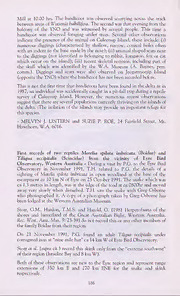
From Field and Study: First records of two reptiles Morelia spilota imbricata (Boidae) and Tiliqua occipitalis (Scincidae) from the vicinity of Eyre Bird Observatory, Western Australia PDF
Preview From Field and Study: First records of two reptiles Morelia spilota imbricata (Boidae) and Tiliqua occipitalis (Scincidae) from the vicinity of Eyre Bird Observatory, Western Australia
Mill at 10.00 hrs. The bandicoot was observed scurrying across the track between areas of Watsonia bulbillifera. The second was that evening from the balcony of the YNO and was witnessed by several people. This time a bandicoot was observed foraging under trees. Several other observations indicate the presence of the animal on Culeenup Island, these include: (i) numerous diggings (characterised by shallow, narrow, conical holes often with an indent in the base made by the nose); (ii) unusual shaped scats next to the diggings (not identified as belonging to rabbit, kangaroo, fox or cat which occur on the island); (iii) recent skeletal remains, including part of the skull which was identified by the W.A. Museum (A. Baynes, pers. comm.). Diggings and scats were also observed on Jeegamyeejip Island (opposite the YNO) where the bandicoot has not been recorded before. This is not the first time that bandicoots have been found in the delta as in 1987, an individual was accidentally caught in a pit-fall trap during a reptile survey of Culeenup Island. However, the numerous recent observations suggest that there are several populations currently thriving on the islands of the delta. :The isolation of the islands may provide an important refuge for this species. - MELVYN J. LINTERN and SUZIE P. ROE, 24 Fairfield Street, Mt. Hawthorn, W.A. 6016. First records of two reptiles Morelia spilota imbricata (Boidae) and T iliqua occipitalis (Scincidae) from the vicinity of Eyre Bird Observatory, Western Australia - During a visit by P.G. to the Eyre Bird Observatory in November 1991, T.H. related to P.G. the derails of a sighting of Morelia spilota imbricata in open woodland at the base of the escarpment ca 10 km N of Eyre on 25 October 1991. The snake which was ca 1.3 metres in length, was at the edge of the road at ca 0800hr and moved away very slowly when disturbed. T.H. saw the snake with Greg Osborne who photographed it. A copy of a photograph taken by Greg Osborne has been lodged at the Western Australian Museum. Storr, G.M., Hanlon, T.M.S. and Harold, G. (1981 Herpetofauna of the shores and hinterland of the Great Australian Bight, Western Australia. Rec. West. Attsr. Mus. 9: 23-39) do not record this or any other members of the family Boidae from their region. On 21 November 1991, P.G. found an adult Tiliqua occipitalis under corrugated iron at "nine mile hut” ca 14 km W of Eyre Bird Observatory. Storr et al. (supra cit.) record this skink only from the “extreme southwest” of their region (Israelite Bay and 8 km W). Both of these observations are new to the Eyre region and represent range extensions of 350 km E and 270 km ENE for the snake and skink respectively. 186 P. Congreve (1985 Reptiles recorded from the vicinity of Eyre Bird Observatory, Eyre Bird Observatory Report 1981 - 1983; 3: 125-128) mentions two other taxa which were collected after the publication of Storr et al. (supra cit.): namely Ctenotus uber uber (Scincidae) and Chelonia mydas (Cheloniidae). These records bring the perpetofauna of the region covered by Storr et al. to 11 families, 37 genera and 74 species and subspecies. -PHILLIP GRIFFIN c/o 3 Evershed Street, Myaree 6154 Western Australia and TIM HUNT c/o Eyre Bird Observatory c/o Cocklebiddy vie Norseman 6443 Western Australia. First Record of a Gould’s Petrel Pterodroma leucoptera (Gould) in Western Australia - On 10 December 1990 Mr and Mrs G. Goodreid, Wardens of the Eyre Bird Observatory, found a small dead and partly eaten petrel near Eyre, Western Australia. The bird was donated to the Western Australian Museum where it was prepared into a mummified specimen (registered number A23837) and identified as Pterodroma leucoptera. Details of the specimen are as follows: total length 290mm; exposed culnren 26.0 mm; entire culnren 36.0 mm; culmen width 8.4 mm; wing 220 mm; tail 99 mm; tarsus 29 mm; middle toe and claw 36 mm; forehead white scalloped with black; crown and nape blackish; base of bill and cheeks white; upper back dark grey to grey; wings mostly blackish, primaries with white wedge at base of inner web, secondaries mostly grey with white inner web; rump blackish grey; central tail feathers mostly dark grey tinged blackish at tip and with white at base on inner web, outer feathers (except outermost) grey with white increasing on inner web, outermost feather with grey outer web and white inner web peppered with grey near tip; ;underparts white except for patch of dark grey on side of breast; underwing white with blackish tips to flight feathers and dark leading edge of wing angling in at carpal joint to form a blackish carpal bar. In Australian waters Gould’s petrel breeds only on Cabbage Tree island off Port Stephens, New South Wales, it is a summer breeder, the birds returning to the island in October, egg laying begins in November and the adults and young leave in March/April (Marchant and Higgins 1990, Handbook of Australian, New Zealand and Antarctic Birds). The birds are absent from the breeding site from May to October and their movements away from the breeding ground are largely unknown. Beach washed birds have been found in Victoria, New South Wales and Queensland. - R.E. JOHNSTONE, Western Australian Museum, Perth. 187
